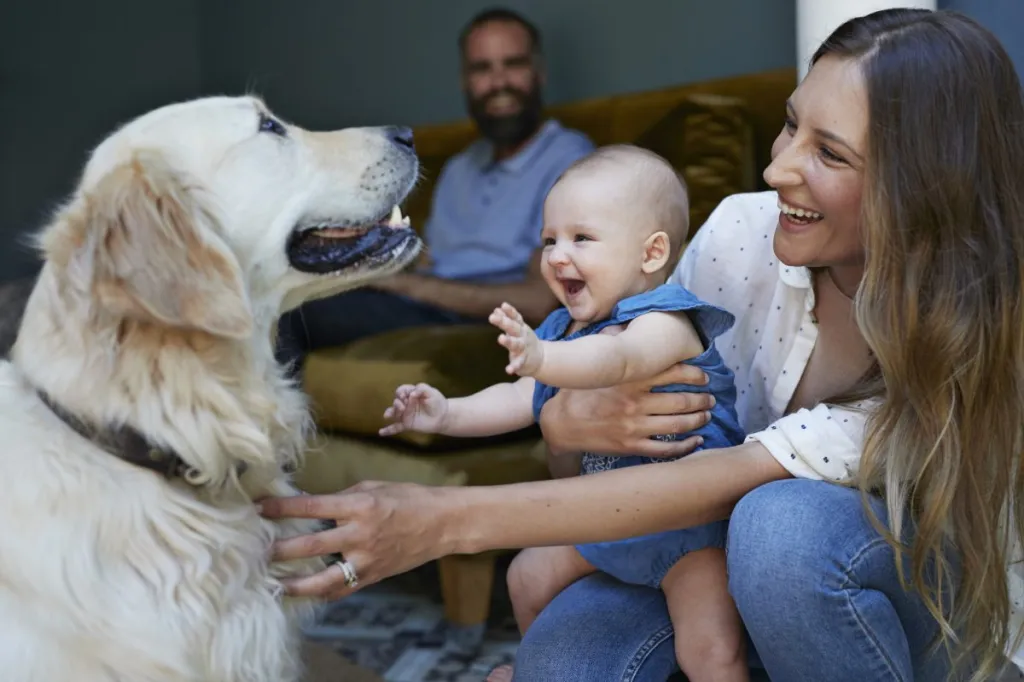To raise a people-friendly dog, expose your dog to a variety of people and have them offer treats when the dog behaves well. Leash your dog at all times for better control.
This will help your dog associate strangers with positive experiences and overcome fear or dislike.

Credit: m.facebook.com
Benefits Of A People-friendly Dog
A people-friendly dog can bring numerous benefits to your life and the community. From improved social interactions to enhanced safety and control, having a dog that is friendly towards people can make a significant difference in the overall well-being of both you and your furry companion.
Improved Social Interactions
One of the key benefits of having a people-friendly dog is the improved social interactions it brings. When your dog is friendly towards people, it becomes easier to introduce them to new friends, family members, and even strangers. This can help you build stronger relationships and create a more inclusive and connected community. With a people-friendly dog by your side, you’ll find it easier to strike up conversations, make new acquaintances, and feel more at ease in social settings.
Enhanced Safety And Control
Another significant advantage of having a people-friendly dog is the enhanced safety and control it provides. When your dog is friendly towards people, you can trust their behavior and feel confident in their interactions with others. This makes it easier to manage your dog in public spaces, ensuring both their safety and the safety of those around you. By having a people-friendly dog, you can avoid situations where your dog may become aggressive or fearful towards strangers, reducing the risk of accidents or confrontations.
In summary, having a people-friendly dog comes with a range of benefits that can positively impact your life. From improved social interactions to enhanced safety and control, a dog that is friendly towards people can bring joy, comfort, and peace of mind. So, invest the time and effort into raising a people-friendly dog, and enjoy the many rewards that come with it.
Tips For Socializing Your Dog
HTML Content:Socializing your dog is an important aspect of raising a people-friendly pet. Proper socialization helps your dog feel comfortable and confident in various situations, reduces fear and aggression, and promotes positive interactions with both humans and other animals. Here are some essential tips to help you socialize your dog effectively:
Start Socializing Early
Starting the socialization process as early as possible is crucial. Puppies are most receptive to new experiences and learning during their early development stages. Expose your dog to different environments, people, and animals while ensuring that the interactions are positive and safe. This will help them develop a well-rounded and friendly temperament.
Be Consistent With Training
Consistency is key when it comes to training and socializing your dog. Establish clear rules and boundaries, and make sure everyone in the household follows them consistently. Use positive reinforcement techniques, such as rewards and praises, to reinforce good behavior. Consistent training will help your dog understand what is expected of them and build their confidence in various social situations.
Supervise Interactions
When socializing your dog, it is important to supervise all interactions to ensure their safety and the safety of others. Keep your dog on a leash or in a controlled environment when introducing them to new people or animals. This allows you to have control and intervene if necessary. Gradually increase the level of exposure and closely monitor your dog’s reactions and body language to ensure a positive experience.
Use Positive Reinforcement
Positive reinforcement is a powerful tool in socializing your dog. Whenever your dog behaves well towards people or other pets, reward them with treats, praises, and affection. This positive association helps them understand that social interactions are pleasant and rewarding. Avoid using punishment or fear-based training methods as they can create anxiety and aggression in your dog.
By following these tips for socializing your dog, you can raise a people-friendly companion who is well-adjusted and confident in various social settings. Remember, patience and consistency are key in the socialization process. So start early, be consistent with training, supervise interactions, and use positive reinforcement to help your furry friend become a social butterfly.
Dealing With Fear Or Aggression Towards Strangers
To raise a people-friendly dog, expose them to a wide range of individuals and situations. Keep them on a leash to maintain control and have friends offer treats when your dog behaves well around strangers. This positive association will help them overcome fear or aggression towards unfamiliar people.
Identifying The Cause Of Fear Or Aggression
If your dog displays fear or aggression towards strangers, it is essential to first identify the cause of their behavior. Some dogs may have had negative experiences in the past, leading to fear or anxiety when encountering unfamiliar people. Others may have a lack of socialization during puppyhood, which can contribute to a general apprehension towards strangers. Identifying the specific trigger for your dog’s fear or aggression is crucial in developing an effective training plan.Gradual Exposure And Positive Reinforcement
One effective way to address fear or aggression towards strangers is through gradual exposure and positive reinforcement. Start by exposing your dog to a wide variety of people in controlled environments. Keep your dog on a leash at all times, allowing you to maintain control and ensure everyone’s safety. During these interactions, have your friends or family members offer treats to your dog whenever they display calm and friendly behavior. This positive reinforcement helps your dog associate strangers with positive experiences and rewards. With time and repetition, your dog will begin to overcome their fear or aggression towards strangers and develop more people-friendly behavior.Implementing Gradual Exposure And Positive Reinforcement
Here are some steps you can take to implement gradual exposure and positive reinforcement effectively:- Start with familiar individuals: Begin by introducing your dog to people they are already comfortable with, such as family members or close friends. This helps build their confidence and establishes a positive association with human interaction.
- Progress to unfamiliar individuals: Once your dog becomes more at ease with familiar individuals, gradually introduce them to strangers. Start with people who have a calm and gentle demeanor. Allow your dog to approach them at their own pace, and reward them with treats for calm and friendly behavior.
- Expand the social circle: As your dog becomes more comfortable with strangers, continue to expose them to new people. It’s crucial to vary the age, gender, and appearance of individuals to ensure your dog becomes comfortable with different types of people.
- Consistency is key: Be consistent in your approach and continue to provide positive reinforcement whenever your dog displays friendly behavior towards strangers. Consistency helps to reinforce the desired behavior and solidify their positive associations.

Credit: www.pinterest.com
Techniques To Raise A Friendly Dog
Introduce your dog to a variety of people and situations to raise a friendly and sociable pup. Use positive reinforcement and treats to associate strangers with good experiences and help your dog overcome fear and anxiety.
Raising a people-friendly dog requires intentional steps to socialize and train your furry friend. By introducing them to new experiences, encouraging positive interactions with guests, and practicing basic commands and obedience training, you can foster a friendly and well-behaved companion.
Introduce Your Dog To New Experiences
To raise a people-friendly dog, it’s crucial to expose them to a wide variety of experiences from an early age. This exposure helps your dog become accustomed to different sights, sounds, and environments, reducing fear and anxiety in new situations. Take your dog on walks in different neighborhoods, invite them to family outings, or bring them to dog-friendly parks to interact with other animals. Remember to keep your dog on a leash for control while experiencing these new adventures.
Encourage Positive Interactions With Guests
Your friends or family members might be visiting your home frequently, and it’s essential to make these interactions positive for your dog. Have your guests offer treats to your dog when they exhibit good behavior. This association between treats and strangers can help your dog overcome their fear or dislike of new people. Remind your guests to approach your dog calmly and avoid sudden movements that may startle them. Building positive experiences with guests can lead to a more people-friendly dog.
Practice Basic Commands And Obedience Training
Basic commands and obedience training are fundamental in raising a people-friendly dog. Start with simple commands like sit, stay, and come. Consistency is key in this training, so ensure everyone in your household uses the same words and hand signals. Establishing clear communication channels through training builds trust between you and your dog. This trust forms the foundation for a well-behaved and friendly companion.
In conclusion, implementing these techniques – introducing your dog to new experiences, encouraging positive interactions with guests, and practicing basic commands and obedience training – will help you raise a people-friendly dog. Consistency, patience, and positive reinforcement play crucial roles in shaping your dog’s behavior. With time and dedication, you can enjoy the company of a friendly, socialized, and well-behaved furry friend.
Creating A Friendly Environment At Home
Create a friendly environment at home by raising a people-friendly dog. Expose your dog to various people, keep them on a leash, and have friends offer treats for good behavior. With consistent training and socialization, your dog will overcome fear and become more comfortable around strangers.
Invite A Variety Of People To Your Home
One of the most effective ways to create a friendly environment at home is to expose your dog to a wide variety of people. This helps them become comfortable and familiar with different types of individuals, reducing the likelihood of fear or aggression towards strangers in the future. Take the initiative to invite friends, family members, and even acquaintances to your home to meet and interact with your furry friend. It’s important to note that during these interactions, always keep your dog on a leash so you can maintain control over their behavior and ensure everyone’s safety.
Include Men, Children, And Other Pets
When inviting people to your home, make sure to include individuals from various demographics, such as men, children, and other pets. This exposure allows your dog to become accustomed to different genders, age groups, and species, teaching them to be friendly and accepting towards a diverse range of individuals. When men and children interact with your dog, they may have different energy levels or behaviors compared to women or adults, so it’s crucial for your dog to become familiar with these differences. Additionally, if you have other pets in your household, introducing them to your dog will help establish positive relationships, promoting socialization and a harmonious environment at home.
Organize Puppy Parties And Social Gatherings
Another great way to promote a friendly environment at home is by organizing puppy parties and social gatherings. These gatherings provide an opportunity for your dog to socialize with other dogs and meet new people in a controlled and supervised environment. Ensure that each pet and owner attending the party is responsible and respectful of boundaries to prevent any incidents or negative experiences. Puppy parties not only allow your dog to build important social skills but also provide an outlet for their energy and playfulness. Don’t forget to offer treats and rewards for good behavior during these gatherings, reinforcing positive interactions and encouraging friendly behavior.

Credit: dogtime.com
Frequently Asked Questions On Raising A People-friendly Dog
How Do I Make My Dog People Friendly?
To make your dog people friendly, expose them to different individuals. Keep them on a leash for control. Have friends give treats when the dog behaves well. Associating treats with strangers will help them overcome fear and dislike.
How Do You Control An Overly Friendly Dog?
To control an overly friendly dog, keep them on a leash at all times and expose them to a variety of people. Have friends offer treats when the dog behaves well towards them, to help them associate strangers with positive experiences.
Avoid dog parks and draw their attention elsewhere if they become too friendly.
Why Won’t My Dog Let Strangers Pet Him?
Dogs may not let strangers pet them due to past negative experiences, lack of socialization, or fear of unfamiliar people. Positive reinforcement training can help them associate strangers with treats and overcome their fear.
How Do I Train My Dog To Not Be Aggressive Towards Strangers?
To train your dog to not be aggressive towards strangers: 1. Expose your dog to different people and keep them on a leash for control. 2. Have friends offer treats when your dog behaves well with strangers. 3. Create positive associations by rewarding good behavior around strangers.
4. Practice training steps on your own, like gradually introducing your dog to someone standing far away. 5. Use positive reinforcement, treats, and praise to reinforce calm behavior.
Conclusion
Raising a people-friendly dog requires patience, consistency, and positive reinforcement. Exposing your dog to various individuals and situations from a young age helps them become comfortable and sociable. Hand-feeding, practicing basic commands, and encouraging interactions with guests and children can also contribute to their friendliness.
By following these strategies, you can help your dog overcome fear and develop positive associations with people, ensuring a happier and more sociable companion.






